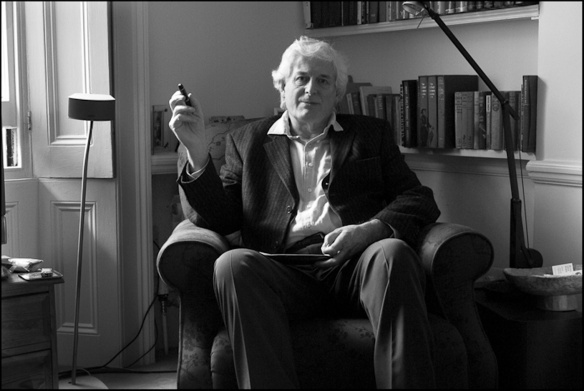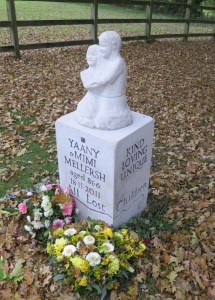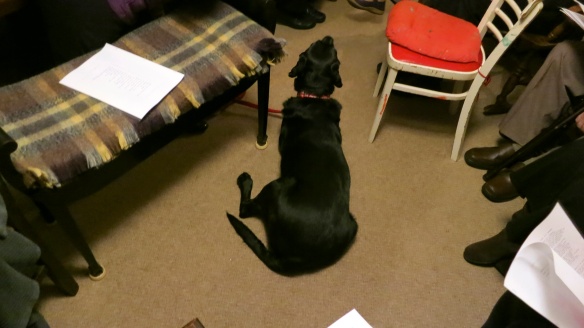 In my post dedicated to him, I say that Alex Schneideman made me a present of one of his portraits of me. This is number 21 in the ‘through the ages series’, taken on 17th March 2009. It seems appropriate to feature it at this time, because behind me in the flat in Sutherland place, are some of the books that now fill boxes in the garage. Becky has recently quoted Daisy Ashford’s ‘The Young Visiters’ on her Facebook page. Among the comments this has prompted is Jackie’s regret that she no longer has her copy.
In my post dedicated to him, I say that Alex Schneideman made me a present of one of his portraits of me. This is number 21 in the ‘through the ages series’, taken on 17th March 2009. It seems appropriate to feature it at this time, because behind me in the flat in Sutherland place, are some of the books that now fill boxes in the garage. Becky has recently quoted Daisy Ashford’s ‘The Young Visiters’ on her Facebook page. Among the comments this has prompted is Jackie’s regret that she no longer has her copy.  I have assured her that she need have no fear because my copy will be in the box marked Novels A – ?. Since some of the Bs and Cs can be seen on the shelves to my left, the young writer’s famous tale is probably sharing their temporary resting place. It is to be hoped that Jackie does not want to read the book before the boxes are unloaded at their final destination.
I have assured her that she need have no fear because my copy will be in the box marked Novels A – ?. Since some of the Bs and Cs can be seen on the shelves to my left, the young writer’s famous tale is probably sharing their temporary resting place. It is to be hoped that Jackie does not want to read the book before the boxes are unloaded at their final destination.
This morning I walked to the churchyard via The Splash and footpath, and back through the village. Clopping up the road between the ford and Furzey Gardens was a Thelwell pony, led by a woman in wellies, and carrying a proud little girl. They were grateful to be photographed.

 On 16th November, when I was too unwell to attend, there was a ceremony of dedication to the Memorial to Lost Children sculpted by Jeanie Mellersh, whose had been one of the first welcoming faces I met soon after our arrival in Minstead. It seemed appropriate, on a Sunday of my first real walk since getting over my virus, to pay my respects to the memory of Jeanie and Nick’s grandchildren Yaany & Mimi Mellersh, local children who lost their lives tragically in Turkey two years ago. I did so. The white stone memorial stands apart from the graves. One can only extend sympathy to those left behind.
On 16th November, when I was too unwell to attend, there was a ceremony of dedication to the Memorial to Lost Children sculpted by Jeanie Mellersh, whose had been one of the first welcoming faces I met soon after our arrival in Minstead. It seemed appropriate, on a Sunday of my first real walk since getting over my virus, to pay my respects to the memory of Jeanie and Nick’s grandchildren Yaany & Mimi Mellersh, local children who lost their lives tragically in Turkey two years ago. I did so. The white stone memorial stands apart from the graves. One can only extend sympathy to those left behind.
This afternoon we drove to Hobby Craft in Hedge End to buy the materials for a Christmas present picture frame. Afterwards we went on to Margery and Paul’s home in Bitterne for the grand finale of The First Gallery’s three week winter exhibition. Incidentally they sold 6/10 of mine and Jackie’s cards.
The exhibition closed at 4.00 p.m. and the sing song by private invitation began at 4.30. As smooth as clockwork the conjoint sitting rooms were transformed from a picture gallery to a splendid parlour room for group singing. Masterminded by Paul with some assistance from the early arrivals, items were whisked upstairs or into the hall to make way for a variety of chairs. Everything except the pianist was in place by the appointed time.  Mary, our musician, had been delayed. This was no problem for the dynamic duo as Margery gamely took over the keyboard and got us under way.
Mary, our musician, had been delayed. This was no problem for the dynamic duo as Margery gamely took over the keyboard and got us under way.
Part of the preparation had been the printing off and stapling of song sheets. This involved various singers supervising the PC, then, by distributing the various sheets on various knees and collecting them up in the correct order, collating them before applying a stapler.
There were two sets of songs; one of carols, and the other of what Paul termed ‘pagan songs’ like Clementine or ‘Enery The Eighth. Examples of each were alternated in our programme, and great fun was had by all.
As Margery was getting into the swing of things at the piano Paul came staggering backwards into the room. Looking rather like the anchorman in a tug of war he managed to dig his heels into the carpet, and, with head bobbing and hair flying, heave on a taught red rope that disappeared the other side of the door. As did Paul, rather like a puppet on a string. Summoning all his strength he got himself and what turned out to be a dog lead back into the room. Momentarily. On the other end of the leash was a black labrador seemingly larger than the pony I had seen this morning. It had its forepaws on the shoulders of a woman whose gradual entry into the room meant Paul could relax somewhat,  only to be jerked across to the piano where Mary, the pianist, helped him secure her dog Gem to the piano stool. Naturally this created a pause in the proceedings.
only to be jerked across to the piano where Mary, the pianist, helped him secure her dog Gem to the piano stool. Naturally this created a pause in the proceedings.
 Mary then took over the ivories.
Mary then took over the ivories. All continued comparatively smoothly until Gem took a shine to John. I felt for him as he tried to manage the farmyard sounds of ‘Old MacDonald’ whilst fending off a besotted dog with strokes of self defence. Nevertheless, the more or less harmonious production continued until it was time for a break.
All continued comparatively smoothly until Gem took a shine to John. I felt for him as he tried to manage the farmyard sounds of ‘Old MacDonald’ whilst fending off a besotted dog with strokes of self defence. Nevertheless, the more or less harmonious production continued until it was time for a break.
At the interval we were served with tea and Margery’s exquisite mini mince pies, still warm and delicious.
When the singing was ended, the majority of us stayed and had a very enjoyable half hour or so of stimulating and entertaining conversation.
Elizabeth, Jackie and I then repaired to Eastern Nights at Thornhill for the usual top quality Bangladeshi meal with Cobra, Bangla, and fizzy water to accompany it.






